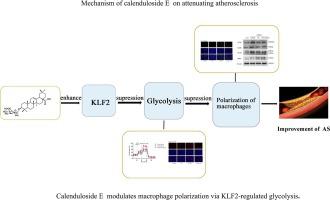International Immunopharmacology ( IF 4.8 ) Pub Date : 2023-03-04 , DOI: 10.1016/j.intimp.2023.109730 Lanfang Li 1 , Junyu Mou 2 , Yanwei Han 3 , Min Wang 1 , Shan Lu 1 , Qiuxiao Ma 4 , Jialu Wang 1 , Jingxue Ye 1 , Guibo Sun 1

|
Glycolysis-mediated macrophage polarization plays a crucial role in atherosclerosis. Although it is known that calenduloside E (CE) exerts anti-inflammatory and lipid-lowering effects in atherosclerosis, the underlying mechanism of action is not clearly understood. We hypothesized that CE functions by inhibiting M1 macrophage polarization via regulation of glycolysis. To verify this hypothesis, we determined the effects of CE in apolipoprotein E deficient (ApoE-/-) mice and on macrophage polarization in oxidized low-density lipoprotein (ox-LDL)-induced RAW 264.7 macrophages and peritoneal macrophages. We also determined whether these effects are linked to regulation of glycolysis both in vivo and in vitro. The plaque size was reduced, and serum cytokine levels were decreased in the ApoE-/- +CE group compared with that in the model group. CE decreased lipid droplet formation, inflammatory factor levels, and mRNA levels of M1 macrophage markers in ox-ldl-induced macrophages. CE suppressed ox-ldl-induced glycolysis, lactate levels, and glucose uptake. The relationship between glycolysis and M1 macrophage polarization was demonstrated using the glycolysis inhibitor 3-(3-pyridinyl)-1-(4-pyridinyl)-2-propen-1-one. CE substantially upregulated ox-ldl-induced Kruppel-like transcription factor (KLF2) expression, and the effects of CE on ox-ldl-induced glycolysis and inflammatory factor levels disappeared after KLF2 knockdown. Together, our findings suggest that CE alleviates atherosclerosis by inhibiting glycolysis-mediated M1 macrophage polarization through upregulation of KLF2 expression, providing a new strategy for the treatment of atherosclerosis.
中文翻译:

金盏花苷 e 通过 KLF2 调节的糖酵解调节巨噬细胞极化,有助于减轻动脉粥样硬化
糖酵解介导的巨噬细胞极化在动脉粥样硬化中起着至关重要的作用。虽然已知金盏花苷 E (CE) 在动脉粥样硬化中发挥抗炎和降脂作用,但其潜在的作用机制尚不清楚。我们假设 CE 通过调节糖酵解抑制 M1 巨噬细胞极化来发挥作用。为了验证这一假设,我们确定了 CE 对载脂蛋白 E 缺陷 (ApoE -/- ) 小鼠的影响以及对氧化低密度脂蛋白 (ox-LDL) 诱导的 RAW 264.7 巨噬细胞和腹膜巨噬细胞中巨噬细胞极化的影响。我们还确定了这些影响是否与体内和体外糖酵解的调节有关。ApoE -/-斑块大小减小,血清细胞因子水平降低+CE组与模型组比较。CE 降低了 ox- ldl诱导的巨噬细胞中的脂滴形成、炎症因子水平和 M1 巨噬细胞标志物的 mRNA 水平。CE 抑制了 ox- ldl诱导的糖酵解、乳酸水平和葡萄糖摄取。使用糖酵解抑制剂 3-(3-pyridinyl)-1-(4-pyridinyl)-2-propen-1-one 证明了糖酵解和 M1 巨噬细胞极化之间的关系。CE 显着上调 ox- ldl诱导的 Kruppel 样转录因子 (KLF2) 表达,以及 CE 对 ox- ldl的影响诱导的糖酵解和炎症因子水平在 KLF2 敲低后消失。总之,我们的研究结果表明,CE 通过上调 KLF2 表达抑制糖酵解介导的 M1 巨噬细胞极化来减轻动脉粥样硬化,为治疗动脉粥样硬化提供了新策略。































 京公网安备 11010802027423号
京公网安备 11010802027423号